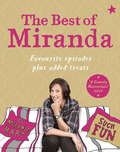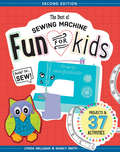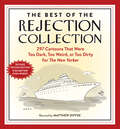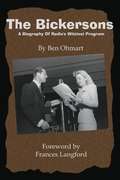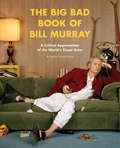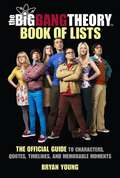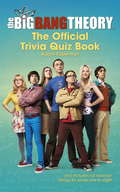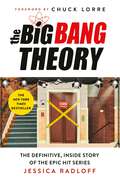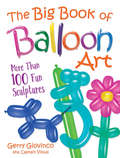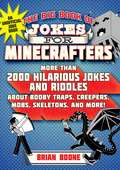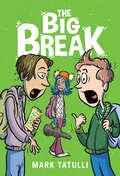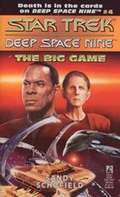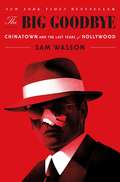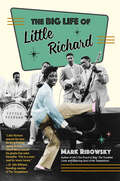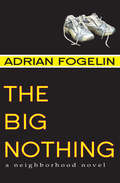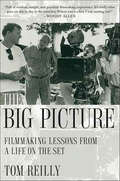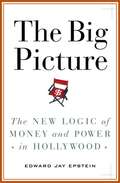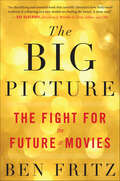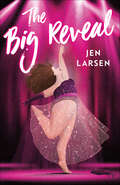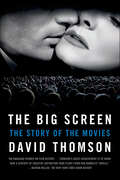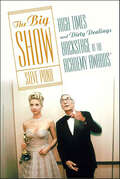- Table View
- List View
The Best of Miranda: Favourite episodes plus added treats – such fun!
by Miranda HartWell hello to you, Dear Book Peruser and thank you for your kind interest in my book o'Miranda. Here you will find my favourite six scripts, hand-picked from all three series, with introductions by moi, and some other tit-bits, and silliness. Because no book of this ilk should be without tit-bits and silliness. If nothing else it's fun to say tit-bits. Repeat after me: tit-bits. You're welcome. I hope you enjoy seeing the scripts in their pure written form on the page before they translated to what you have seen on screen. And if you're a lovely young person still at school let me know if your drama teacher ever lets you do an episode for the school play. Nothing would make me happier. Though I bagsy play Miranda. Your favourite, number one bestselling, comedian Miranda Hart is giving you an access-all-areas VIP backstage pass to her award-winning sitcom. Miranda Hart has won bundles of awards, written a bestselling book and completed a sell-out nationwide tour.But it was her award-winning BBC sitcom Miranda which first made her a much-loved household name. Here Miranda gives us an access-all-areas VIP backstage pass to Miranda the sitcom. The Best of Miranda is a beautiful and hilarious book which will delight Miranda's many fans and earn her many new ones.
The Best of Miranda: Favourite episodes plus added treats – such fun!
by Miranda HartWell hello to you, Dear Book Peruser and thank you for your kind interest in my book o'Miranda. Here you will find my favourite six scripts, hand-picked from all three series, with introductions by moi, and some other tit-bits, and silliness. Because no book of this ilk should be without tit-bits and silliness. If nothing else it's fun to say tit-bits. Repeat after me: tit-bits. You're welcome. I hope you enjoy seeing the scripts in their pure written form on the page before they translated to what you have seen on screen. And if you're a lovely young person still at school let me know if your drama teacher ever lets you do an episode for the school play. Nothing would make me happier. Though I bagsy play Miranda. Your favourite, number one bestselling, comedian Miranda Hart is giving you an access-all-areas VIP backstage pass to her award-winning sitcom. Miranda Hart has won bundles of awards, written a bestselling book and completed a sell-out nationwide tour. But it was her award-winning BBC sitcom Miranda which first made her a much-loved household name. Miranda's identifiable and loveable character, unique wit and physical comedy struck a chord with millions making the show a national institution and Miranda the "Queen of Comedy". Here Miranda gives us an access-all-areas VIP backstage pass to Miranda the sitcom. The Best of Miranda contains the full scripts of Miranda's six favourite episodes (including her original revises and annotations) so that you can, if you wish to, cast your family to re-enact choice moments in your living room. The book also includes Miranda's own account of just what goes in to the process of writing, rehearsing and filming, hilarious gossip from the making of the sitcom, previously unpublished photographs and material which didn't make the final edits. Other extras include recipes for Gary's favourite cakes, cringeworthy childhood photos of our favourite comedian, a step-by-step guide to making your own Fruit Friends and Vegetapals and a Marry Gary Board Game. The Best of Miranda is a beautiful and hilarious book which will delight Miranda's many fans and earn her many new ones.
The Best of Sewing Machine: Fun For Kids
by Nancy Smith Lynda MilliganTeach children to sew on a machine with kid-friendly, boredom-busting projects! Start off your kids on a lifelong sewing adventure with simple projects they&’ll love to make. Starting with basic handmade cards and accessories to learn their machine, they&’ll work their way up to challenging projects like a notebook cover and drawstring backpack. With safety tips, skill-building games to play, and puzzles to practice and remember all they&’ve learned, this updated second edition from sewing educators Lynda Milligan and Nancy Smith is ideal for kids. Make a button-up owl * a mix-and-match monster * a backpack * a greeting card * a treasure pouch * and more! Includes extensive illustrations and diagrams
The Best of the Rejection Collection: 297 Cartoons That Were Too Dark, Too Weird, or Too Dirty for The New Yorker
by Matthew DiffeeThe best of the worst: these cartoons rejected by The New Yorker were deemed too dumb, too weird, or too naughty—but not for lack of laughs! Every week, hundreds and hundreds of cartoons pour into The New Yorker. Most are rejected. Doesn&’t matter how big a deal the cartoonist is, either. Roz Chast, David Sipress, Kim Warp, Sam gross, Ed Steed, Emily Flake, Navied Mahdavian, or Mary Lawton—if the work in question is too weird, too naughty, too juvenile, or too dark, it&’s out. Luckily for us, Matthew Diffee has been bravely sifting through the circular file to rescue the best of the worst. Here are 297 cartoons in a revised second edition featuring more than 50 new cartoons—even better, even worse! The cartoon set-ups may be familiar—a couple in bed, a few people stranded on a desert island, a doctor and patient in an examining room—but the joke are anything but, with twists so unexpected, you can&’t help but laugh out loud.
The Bible on Silent Film
by David J. ShepherdBetween the advent of motion pictures in the 1890s and the close of the 'silent' era at the end of the 1920s, many of the longest, most expensive and most watched films on both sides of the Atlantic drew upon biblical traditions. David J. Shepherd traces the evolution of the biblical film through the silent era, asking why the Bible attracted early film makers, how biblical films were indebted to other interpretive traditions, and how these films were received. Drawing upon rarely seen archival footage and early landmark films of directors such as Louis Feuillade, D. W. Griffith, Michael Curtis and Cecil B. DeMille, this history treats well-known biblical subjects including Joseph, Moses, David and Jesus, along with lesser-known biblical stars such as Jael, Judith and Jephthah's daughter. This book will be of great interest to students of Biblical studies, Jewish studies and film studies.
The Bickersons: A Biography of Radio's Wittiest Program
by Ben OhmartA lively biography of an old-time radio comedy family whose humor still makes us laugh! Other books about old-time radio shows are available from Bookshare.
The Big Activity Book for Anxious People (Big Activity Book Ser.)
by Jordan Reid Erin Williams'WHO KNEW MY ANXIETY COULD BE SO FUNNY?' Amy Morrison, founder of Pregnant ChickenFeeling anxious? Who isn't! Your most irrational (and sometimes rational) fears are hilarious fodder for this sharp and relatable activity book.These days, anxiety is simply part of the human experience. Part journal, part coloring book, part weird coping mechanisms, and part compendium of soothing facts, The Big Activity Book for Anxious Peoplewill be an outlet for anyone who wants to take a break from reality, laugh through her fears, and realize with every page that she is not alone--and to help her figure out what to do when it's 3AM and she's wide awake worrying about whether she cc'ed the right "Bob" on that email. (Probably.)Activities include: * Fun Facts about Aging!* Public Speaking: A Diagram* Your Hotel Room Carpet: A Petri Dish of Horrors* Obscure Diseases You Probably Don't Have* Zen Mantras For The Anxiously Inclined* Soothing Facts about Hand SanitizerOn a bad day, try coloring in the soothing grandma. On a really bad day, find step-by-step instructions on how to build an underground bunker. Reid and Williams want everyone to remember that they're in good company: anxious people are some of the funniest and most interesting and creative humans on the planet. (They know, because they are two of them.)
The Big Bad Book of Bill Murray: A Critical Appreciation of the World's Finest Actor
by Robert SchnakenbergHe's the sort of actor who can do Hamlet and Charlie's Angels in the same year. He shuns managers and agents and once agreed to voice the part of Garfield because he mistakenly believed it was a Coen brothers film. Bill Murray's extraordinary career is rich with fascinating anecdotes, contradictions, and mystery, from his early success on Saturday Night Live and the biggest blockbusters of the 1980s (Caddyshack, Stripes, Tootsie, Ghostbusters) to his reinvention as a hipster icon in the early 21st century (in films like Lost in Translation and Moonrise Kingdom). And now you can get your fill of Bill: part biography, part critical appreciation, part love letter, and all fun, The Big Bad Book of Bill Murray chronicles every single Murray performance in loving detail, relating all the milestones, yarns, and controversy in the life of this beloved but enigmatic performer. These pages are packed with color film stills and behind-the-scenes photography.From the Trade Paperback edition.
The Big Bands
by George T. SimonGeorge T. Simon introduces you to the big band leaders during the period spanning 1935 to 1946.
The Big Bang Theory Book of Lists: The Official Guide to Characters, Quotes, Timelines, and Memorable Moments
by Bryan YoungCelebrate the nerdiest friend group with this ultimate fan guide packed with trivia, facts, and memories from all twelve seasons of The Big Bang Theory. With more than 100 inventive lists, charts, and timelines, The Big Bang Theory Book of Lists offers fans a creative way of looking at and celebrating the iconic and beloved early 2000s sitcom. Revisit some of your favorite moments, pairings, cameos, and geeky references (or test your super-fan knowledge) with these fun groupings exploring the variables of life in apartment 4A.Lists include:Timelines of all the characters, their romantic partnerships, vows, and weddings Analysis of Sheldon's Public Restroom KitAll of Penny&’s Relationship AdvicePictorial Records for Sheldon, Leonard, Penny, Howard, Raj, Amy, and BernadetteRecord of all of the guests (cameos) in the apartmentDiagram of The Universe of All WomenEverything that's in Bernadette's Grab BagA break-down of all of Sheldon's geeky shirts and their referencesAnd more!Illustrated with full-color photographs and visuals from the show throughout, The Big Bang Theory Book of Lists is an officially licensed, must-have collector's item for the ultimate fan.THE BIG BANG THEORY and all related characters and elements © & ™ Warner Bros. Entertainment Inc. (s22)
The Big Bang Theory Trivia Quiz Book
by Adam Faberman Warner BrosWhat did Amy name her electric toothbrush?What does Leonard bring Penny back from the North Pole? The Big Bang Theory Trivia Quiz Book is the first official book to accompany one of the world's favourite and funniest comedies. Including 1,600 questions from series 1 to 8, along with photos, hilarious quotes, a complete episode guide and fun features, such as excerpts from the Roommate Agreement and your chance to play 'Emily or Cinnamon', this book will remind you of all your favourite Big Bang moments.
The Big Bang Theory: The Definitive, Inside Story of the Epic Hit Series
by Jessica RadloffThe definitive, behind-the-scenes look at the most popular sitcom of the last decade, The Big Bang Theory, packed with all-new, exclusive interviews with the producers and the entire cast.The Big Bang Theory is a television phenomenon. To the casual viewer, it&’s a seemingly effortless comedy, with relatable characters tackling real-life issues, offering a kind of visual comfort food to its millions of dedicated fans. But the behind-the-scenes journey of the show from a failed pilot to a global sensation is a fascinating story that even the most die-hard fans don&’t know in its entirety. The Big Bang Theory:The Definitive, Inside Story of the Epic Hit Series is a riveting, entertaining look at the sitcom sensation, with the blessing and participation of co-creators Chuck Lorre and Bill Prady, executive producers Steve Molaro and Steve Holland, as well as Johnny Galecki, Jim Parsons, Kaley Cuoco, Simon Helberg, Kunal Nayyar, Melissa Rauch, Mayim Bialik, and more. Glamour senior editor Jessica Radloff, who has written over 150 articles on the series (and even had a cameo in the finale!), gives readers an all-access pass to its intrepid producing and writing team and beloved cast. It&’s a story of on-and-off screen romance told in hilarious and emotional detail, of casting choices that nearly changed everything (which even some of the actors didn&’t know until now), of cast members bravely powering through personal tragedies, and when it came time to announce the 12th season would be its last, the complicated reasons why it was more difficult than anyone ever led on. Through hundreds of hours of interviews with the sitcom&’s major players, Radloff dives into all this and much more. The book is the ultimate celebration of this once-in-a-generation show and a must-have for all fans. AN INSTANT NEW YORK TIMES BESTSELLER A USA TODAY BESTSELLER NAMED A BEST BOOK OF 2022 BY GLAMOUR "Talking with Jessica, I realized how easy it had been for me to kind of put all 12 years of my time on Big Bang Theory under one general umbrella, as it were. The questions she asked and the information she&’d reveal to me from someone else she&’d interviewed forced me into a frame of mind where each season - and sometimes each episode - became it&’s own, separate entity again. . . Frankly, it turned into a version of therapy I hadn&’t realized I&’d needed and couldn&’t have known how much I&’d enjoy." —Jim Parsons
The Big Book of Balloon Art: More Than 100 Fun Sculptures
by Gerry GiovincoThe easiest-to-follow and most comprehensive balloon-sculpting treasury available, this amazing book is packed with over 100 unique designs. Gerry Giovinco presents step-by-step cartoons and schematics that anyone can use to recreate these sculptures. You can start out small with a one-balloon dog and a princess hat and build up to a monkey in a tree, an intricate motorcycle, and reproductions of classic cartoon characters. Gerry clearly explains and shows the sizes of the bubbles you'll need to make as you build your sculpture from the knot up, and he demonstrates the unique folds and twists that result in finished works of art — and instant smiles.Gerry Giovinco is an acclaimed artist, cartoonist, and entertainer. In his clown persona, Captain Visual, he performs and teaches the craft of balloon sculpting throughout the country. The Big Book of Balloon Art is simple enough for kids, and it's great for parents and teachers too. Even seasoned performers will find it a practical and fun-filled way to improve their skills.
The Big Book of Jokes for Minecrafters: More Than 2000 Hilarious Jokes and Riddles about Booby Traps, Creepers, Mobs, Skeletons, and More! (Jokes for Minecrafters)
by Brian Boone Michele Hollow Jordon Hollow Steven Hollow“Dig in” to your favorite Minecraft jokes! All your favorite Minecraft jokes are now in one place! This collection of three titles from the Jokes for Minecrafters series brings you over two thousand puns, one-liners, and wisecracks about all your favorites from the world of Minecraft. From ghasts and endermen to zombies and creepers, no mob is safe from the punchlines in this laugh-a-minute collection. Included titles are: Jokes for Minecrafters (9781510706330), Hilarious Jokes for Minecrafters (9781510706323), Uproarious Riddles for Minecrafters (9781510727175). This ginormous joke book for kids ages 5 and up comes complete with silly illustrations to make these jokes even funnier. Whether you're at home or at school, you can have all your friends and family in stitches with The Big Book of Jokes for Minecrafters!
The Big Break
by Mark TatulliA full-color graphic novel about growing up, growing apart, and monster hunting, perfect for fans of Real Friends and All's Faire in Middle School.Andrew and Russ are best friends obsessed with finding the legendary Jersey Devil that supposedly lives in the Pine Barrens of New Jersey, right in their own backyards. They're even making a movie about their desperate search for any sign of the mythical creature. But when Russ starts spending less time on their movie, and more time with artsy, first-chair violinist Tara, Andrew feels the cracks in their friendship begin to form.Suddenly, all of Andrew's favorite things are too babyish for Russ, and Andrew is left trying to figure out where he belongs without his best friend by his side. Then a rash of Jersey Devil sightings excite their small town, and the boys are thrown back together on a fevered hunt. Can Andrew and Russ put aside their differences for one last chance to find the monster of their dreams, or will the break in their friendship be too big to mend? <P><P> <i>Advisory: Bookshare has learned that this book offers only partial accessibility. We have kept it in the collection because it is useful for some of our members. Benetech is actively working on projects to improve accessibility issues such as these.</i>
The Big Game (Star Trek: Deep Space Nine #Vol. 4)
by Sandy SchofieldWhen Quark holds a poker tournament on Deep Space NineTM someone from almost every sentient race -- Klingons, Cardassians, Romulans, Vulcans, Ferengi -- shows up for what is sure to be the highest-stakes game of all time. But when one player is killed, the stakes get higher than even these big-money players had counted on. With the station rocked by subspace waves that threaten its destruction, Commander Sisko and Security Chief Odo must hunt down the killer in time to save the players, a killer who has information that can save those onboard Deep Space Nine from the invisible enemy they do not even know they face, a killer who holds all the cards...
The Big Goodbye: Chinatown and the Last Years of Hollywood
by Sam WassonFrom the New York Times bestselling author of Fifth Avenue, Five A.M. and Fosse comes the revelatory account of the making of a modern American masterpiece Chinatown is the Holy Grail of 1970s cinema. Its twist ending is the most notorious in American film and its closing line of dialogue the most haunting. Here for the first time is the incredible true story of its making. In Sam Wasson's telling, it becomes the defining story of the most colorful characters in the most colorful period of Hollywood history. Here is Jack Nicholson at the height of his powers, as compelling a movie star as there has ever been, embarking on his great, doomed love affair with Anjelica Huston. Here is director Roman Polanski, both predator and prey, haunted by the savage death of his wife, returning to Los Angeles, the scene of the crime, where the seeds of his own self-destruction are quickly planted. Here is the fevered dealmaking of "The Kid" Robert Evans, the most consummate of producers. Here too is Robert Towne's fabled script, widely considered the greatest original screenplay ever written. Wasson for the first time peels off layers of myth to provide the true account of its creation. Looming over the story of this classic movie is the imminent eclipse of the '70s filmmaker-friendly studios as they gave way to the corporate Hollywood we know today. In telling that larger story, The Big Goodbye will take its place alongside classics like Easy Riders, Raging Bulls and The Devil's Candy as one of the great movie-world books ever written.Praise for Sam Wasson:"Wasson is a canny chronicler of old Hollywood and its outsize personalities...More than that, he understands that style matters, and, like his subjects, he has a flair for it." - The New Yorker"Sam Wasson is a fabulous social historian because he finds meaning in situations and stories that would otherwise be forgotten if he didn't sleuth them out, lovingly." - Hilton Als
The Big Life of Little Richard
by Mark Ribowsky&“This entertaining, fast-paced biography&” of the legendary singer-songwriter &“will thrill fans of Little Richard and early rock and roll&” (Publishers Weekly). Richard Wayne Penniman, known to the world as Little Richard, blazed the trail for generations of musicians: The Beatles, James Brown, the Everly Brothers, Jimi Hendrix, the Rolling Stones, Elton John, Prince . . . the list seems endless. He was &“The Originator,&” &“The Innovator,&” and the self-anointed &“King and Queen of Rock &’n&’ Roll.&” In The Big Life of Little Richard, Mark Ribowsky shares the raucous story of his life from early childhood in Macon, Georgia, to his death in 2020. Ribowsky, acclaimed biographer of musical icons―including the Supremes, the Temptations, Stevie Wonder, and Otis Redding―takes readers through venues, gigs, and studios, conveying the sweaty energy of music sessions limited to a few tracks on an Ampex tape machine and vocals sung along with a live band. He explores Little Richard&’s musicianship; his family life; his uphill battle against racism; his interactions with famous contemporaries and the media; and his lifelong inner conflict between his religion and his sexuality. By 2020, eighty-seven-year-old Little Richard&’s electrifying smile was still intact, as were his bona fides as rock&’s royal architect: the &’50s defined his reign, and he extended elder statesmanship ever since. The Big Life of Little Richard not only explores a legendary stage persona, but also a complex life under the makeup and pomade
The Big Nothing (Neighborhood Novels Ser. #4)
by Adrian FogelinThis sensitive and often humorous book tells the story of an adolescent boy who begins to find himself after the people he has always depended on let him down. Alone. That's how thirteen-year-old Justin feels these days. His older brother Duane has left home, enlisting in the Army, and his father has walked out, maybe for good this time. His mom is too depressed to get out of bed, much less pay the bills and keep food in the refrigerator. And if that's not enough, his best buddy Ben has a new girlfriend and no longer has time to hang out. There's not much left for Justin to do but to put his brain in neutral and slide into the state he calls "the Big Nothing." But slowly Justin discovers he has more resources than he thinks. With the help of his classmate Jemmie and her grandmother, Nana Grace, he learns that underneath all the noisy confusion in his brain lies a talent for music. As he spends time with Jemmie, he begins to understand how simple notes make complex music, and how simple feelings can turn into deep emotions. Award-winning author Adrian Fogelin once again offers readers an emotionally charged story featuring a sympathetic adolescent trying to make sense of the people and world around him.
The Big Picture: Filmmaking Lessons from a Life on the Set
by Tom ReillyFilm production veteran Tom Reilly has worked on the sets of critically praised films and commercial blockbusters for more than three decades?including seventeen years alongside director Woody Allen. In The Big Picture, he explores the art and the craft of filmmaking from the vantage point of someone actually running the movie set. Using examples unlike any of those in other books on film, Reilly exposes not only the power and the personalities, but the secrets of the pros. He shares the insights he gleaned while working with more than sixty Oscar-winning professionals?from Al Pacino, Robert De Niro, and Vanessa Redgrave to Sydney Pollack, Sven Nykvist, and Barbra Streisand. In these fifty entertaining, illuminating short essays, Reilly invites you to join him on the film set. What is it like to shoot a love scene? How do you do a full body burn? What is it like to film in the Everglades or in a morgue? What is blocking or matching, and how long should a script be? How do you decide when to build a set? Why is the color palette so critical? Is night shooting worth the suffering?The Big Picture delivers the surprising answers to these and other fascinating questions about what it takes to make a feature film, offering a glimpse into what it's like when the lights are bright, the camera is rolling, and the moviemakers are calling the shots.
The Big Picture: Money and Power in Hollywood
by Edward Jay EpsteinIn this unprecedented, all-encompassing, and thoroughly entertaining account of the movie business, acclaimed writer Edward Jay Epstein reveals the real magic behind moviemaking: how the studios make their money. Epstein shows that in Hollywood, the only art that matters is the art of the deal: Major films turn huge profits not from the movies themselves but through myriad other enterprises, from video-game spin-offs and soundtracks to fast-food tie-ins, and even theme-park rides. The studios may compete for stars and Oscars, but their corporate parents view with one another in less glamorous markets such as cable, home video, and pay-TV. Money, though, is only a small part of the Hollywood story; the social and political milieus–power, prestige, and status–tell the rest. Alongside its remarkable financial revelations and incisive profiles of the pioneers who helped build Hollywood, The Big Picture is filled with eye-opening insider stories. If you are interested in Hollywood today and the complex and fascinating way it has evolved in order to survive, you haven’t seen the big picture until you’ve read The Big Picture.
The Big Picture: The Fight for the Future of Movies
by Ben FritzA Los Angeles Times Bestseller Winner of the Best Non-Fiction Book Prize at the 2018 National Arts & Entertainment Journalism Awards &“Ben Fritz crafts an electrifying and essential book that carefully chronicles how Hollywood tradition is collapsing and new models are fueling the future. A must-read.&”—Ava DuVernay, director of A Wrinkle in Time, Selma, and 13th The stunning metamorphosis of twenty-first-century Hollywood and what lies ahead for the art and commerce of film Ben Fritz chronicles the dramatic shakeup of America&’s film industry, bringing equal fluency to both the financial and entertainment aspects of Hollywood. He offers us an unprecedented look deep inside a Hollywood studio to explain why sophisticated movies for adults are an endangered species while franchises and super-heroes have come to dominate the cinematic landscape. And through interviews with dozens of key players at Disney, Marvel, Netflix, Amazon, Imax, and others, he reveals how the movie business is being reinvented. Despite the destruction of the studios&’ traditional playbook, Fritz argues that these seismic shifts signal the dawn of a new heyday for film. The Big Picture shows the first glimmers of this new golden age through the eyes of the creative mavericks who are defining what entertainment will look like in the new era.
The Big Reveal
by Jen LarsenA dazzling YA novel about a girl who isn't afraid to be big and sexy and dance her heart out, and a discussion-provoking exploration of the mixed messages our society gives young women about their bodies and sexuality. Addie is a talented dancer, a true-blue friend, and a fat, fierce, and driven young woman. When she's accepted into the prestigious dance company of her dreams, she thinks nothing can bring her down—until she realizes she doesn't have enough money to go. Refusing to give up, Addie and her friends decide to put on a top-secret, invitation-only burlesque show to raise funds. But word soon gets out, and the slut- and body-shaming begin. Has Addie been resisting the patriarchy, or playing right into its hands?The Big Reveal asks hard-hitting feminist questions while reveling in some of life's greatest joys: chasing your passions, falling in love, and embracing yourself exactly as you are.
The Big Screen: The Story of the Movies
by David ThomsonThe Big Screen tells the enthralling story of the movies: their rise and spread, their remarkable influence over us, and the technology that made the screen—smaller now, but ever more ubiquitous—as important as the images it carries.The Big Screen is not another history of the movies. Rather, it is a wide-ranging narrative about the movies and their signal role in modern life. At first, film was a waking dream, the gift of appearance delivered for a nickel to huddled masses sitting in the dark. But soon, and abruptly, movies began transforming our societies and our perceptions of the world. The celebrated film authority David Thomson takes us around the globe, through time, and across many media—moving from Eadweard Muybridge to Steve Jobs, from Sunrise to I Love Lucy, from John Wayne to George Clooney, from television commercials to streaming video—to tell the complex, gripping, paradoxical story of the movies. He tracks the ways we were initially enchanted by movies as imitations of life—the stories, the stars, the look—and how we allowed them to show us how to live. At the same time, movies, offering a seductive escape from everyday reality and its responsibilities, have made it possible for us to evade life altogether. The entranced audience has become a model for powerless and anxiety-ridden citizens trying to pursue happiness and dodge terror by sitting quietly in a dark room.Does the big screen take us out into the world, or merely mesmerize us? That is Thomson's question in this grand adventure of a book. Books about the movies are often aimed at film buffs, but this passionate and provocative feat of storytelling is vital to anyone trying to make sense of the age of screens—the age that, more than ever, we are living in.
The Big Show: High Times and Dirty Dealings Backstage at the Academy Awards
by Steve PondAn unprecedented look at the machinations behind everyone's favorite Hollywood circus and what it reveals about the business of moviemaking.Oscar parties. Oscar pools. Oscar style. Oscar predictions. The Oscars breed their own peculiar mania and a billion people worldwide are alleged to watch the broadcast every year. While that figure may be the Academy's big white lie, the Oscars draw a viewership well into the hundreds of millions--a tremendous audience for what is essentially a television program. But this is no ordinary show. Love it or loathe it, the Oscars are an irresistible spectacle: a gloriously gaudy, glitzy, momentous, and foolish window into the unholy alliance of art and commerce that is the film industry. The Oscar statuette is a totem of such potency that millions are spent and careers laid on the line in the reckless pursuit of an eight-pound chunk of gold-plated britannium. The Big Show is a chronicle of the past fifteen years of the Academy Awards, the most tumultuous decade in Oscar's seventy-six year history. Written by the only journalist ever given carte blanche access to the planning, production, and backstage intrigue of the Oscars, it offers an unguarded, behind-the-scenes glimpse of this singular event, along with remarkable insight into how the Oscars reflect the high-stakes politics of Hollywood, our obsession with celebrities (not to mention celebrities' obsession with themselves), and the cinematic state of the union.
